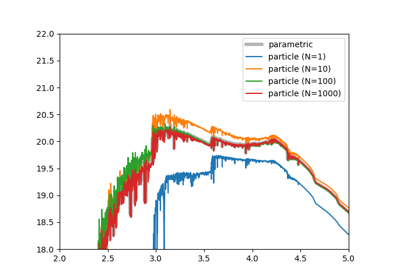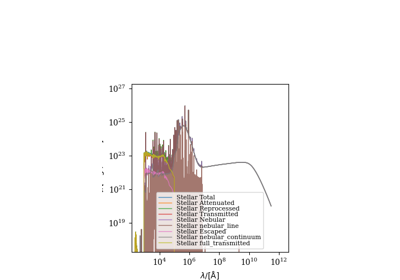synthesizer.particle.stars¶
A module for working with arrays of stellar particles.
Contains the Stars class for use with particle based systems. This contains all the data detailing collections of stellar particles. Each property is stored in (N_star, ) shaped arrays for efficiency.
We also provide functions for creating “fake” stellar distributions, by sampling a SFZH.
In both cases a myriad of extra optional properties can be set by providing them as keyword arguments.
Example usages:
- stars = Stars(initial_masses, ages, metallicities,
redshift=redshift, current_masses=current_masses, …)
- stars = sample_sfzh(sfzh, n, total_initial_mass,
smoothing_lengths=smoothing_lengths, tau_v=tau_vs, coordinates=coordinates, …)
Functions
- synthesizer.particle.stars.sample_sfzh(sfzh, log10ages, log10metallicities, nstar, initial_mass=None, **kwargs)[source]¶
Create “fake” stellar particles by sampling a SFZH.
- Parameters:
sfzh (np.ndarray of float) – The Star Formation Metallicity History grid (from parametric.Stars).
log10ages (np.ndarray of float) – The log of the SFZH age axis.
log10metallicities (np.ndarray of float) – The log of the SFZH metallicities axis.
nstar (int) – The number of stellar particles to produce.
initial_mass (int) – The initial mass of the fake stellar particles. If None, the initial mass is set such that the total mass of the SFZH is split equally among the nstar particles. If set, this mass will override the parametric mass implied by the SFZH, instead using the SFZH as a normalised probability distribution function for sampling ages and metallicities.
**kwargs – Any additional keyword arguments to pass to the Stars constructor.
- Returns:
- stars (Stars)
An instance of Stars containing the fake stellar particles.
Examples using synthesizer.particle.stars.sample_sfzh¶
Classes
- class synthesizer.particle.stars.Stars(initial_masses, ages, metallicities, redshift=None, tau_v=None, alpha_enhancement=None, coordinates=None, velocities=None, current_masses=None, smoothing_lengths=None, s_oxygen=None, s_hydrogen=None, softening_lengths=None, centre=None, metallicity_floor=1e-05, fesc=None, fesc_ly_alpha=None, **kwargs)[source]¶
The base Stars class.
This contains all data a collection of stars could contain. It inherits from the base Particles class holding attributes and methods common to all particle types.
The Stars class can be handed to methods elsewhere to pass information about the stars needed in other computations. For example a Galaxy object can be passed a stars object for use with any of the Galaxy helper methods.
Note that due to the many possible operations, this class has a large number of optional attributes which are set to None if not provided.
- initial_masses¶
The intial stellar mass of each particle in Msun.
- Type:
np.ndarray of float
- ages¶
The age of each stellar particle in yrs.
- Type:
np.ndarray of float
- metallicities¶
The metallicity of each stellar particle.
- Type:
np.ndarray of float
- tau_v¶
V-band dust optical depth of each stellar particle.
- Type:
np.ndarray of float
- alpha_enhancement¶
The alpha enhancement [alpha/Fe] of each stellar particle.
- Type:
np.ndarray of float
- resampled¶
Flag for whether the young particles have been resampled.
- Type:
bool
- current_masses¶
The current mass of each stellar particle in Msun.
- Type:
np.ndarray of float
- smoothing_lengths¶
The smoothing lengths (describing the sph kernel) of each stellar particle in simulation length units.
- Type:
np.ndarray of float
- s_oxygen¶
fractional oxygen abundance.
- Type:
np.ndarray of float
- s_hydrogen¶
fractional hydrogen abundance.
- Type:
np.ndarray of float
- imf_hmass_slope¶
The slope of high mass end of the initial mass function (WIP).
- Type:
float
- nstars¶
The number of stellar particles in the object.
- Type:
int
- fesc¶
The escape fractions of each stellar particle (i.e. the fraction of incident photons that escape the galaxy unreprocessed by the interstellar medium).
- Type:
np.ndarray of float
- calculate_surviving_mass(grid, grid_assignment_method='cic')[source]¶
Calculate the surviving mass of the stellar population.
This is the total mass of stars that have survived to the present day given the star formation and metal enrichment history.
- Parameters:
grid (Grid) – The grid to use for calculating the surviving mass. This is used to get the stellar fraction at each SFZH bin.
grid_assignment_method (str) – The type of method used to assign particles to a SPS grid point. Allowed methods are cic (cloud in cell) or nearest grid point (ngp).
- Returns:
The total surviving mass of the stellar population in Msun.
- Return type:
unyt_quantity
- get_metal_dist(metallicities, grid_assignment_method='cic', nthreads=0)[source]¶
Generate the metallicity distribution in terms of mass.
- Parameters:
metallicities (np.ndarray of float) – The metallicity bins of the desired metallicity distribution.
grid_assignment_method (string) – The type of method used to assign particles to a SPS grid point. Allowed methods are cic (cloud in cell) or nearest grid point (ngp) or their uppercase equivalents (CIC, NGP). Defaults to cic.
nthreads (int) – The number of threads to use in the computation. If set to -1 all available threads will be used. Defaults to 0.
- Returns:
Numpy array of containing the SFH.
- Return type:
numpy.ndarray
- get_sfh(log10ages, grid_assignment_method='cic', nthreads=0)[source]¶
Generate the SFH of these stars in terms of mass.
The SFH is calculated by summing the mass of the particles in each age bin defined by the input log10ages.
- Parameters:
log10ages (np.ndarray of float) – The log10 ages of the desired SFH.
grid_assignment_method (string) – The type of method used to assign particles to a SPS grid point. Allowed methods are cic (cloud in cell) or nearest grid point (ngp) or their uppercase equivalents (CIC, NGP). Defaults to cic.
nthreads (int) – The number of threads to use in the computation. If set to -1 all available threads will be used. Defaults to 0.
- Returns:
Numpy array of containing the SFH.
- Return type:
numpy.ndarray
- get_sfr(timescale=unyt_quantity(10, 'Myr'))[source]¶
Return the star formation rate of the stellar particles.
- Parameters:
timescale (float) – The timescale over which to calculate the star formation rate.
- Returns:
The star formation rate of the stellar particles.
- Return type:
sfr (float)
- get_sfzh(log10ages, metallicities, grid_assignment_method='cic', nthreads=0)[source]¶
Generate the binned SFZH history of these stars.
The binned SFZH is calculated by binning the particles onto the desired grid defined by the input log10ages and metallicities.
The binned SFZH produced by this method is equivalent to the weights used to extract spectra from the grid.
- Parameters:
log10ages (np.ndarray of float) – The log10 ages of the desired SFZH.
metallicities (np.ndarray of float) – The metallicities of the desired SFZH.
grid_assignment_method (string) – The type of method used to assign particles to a SPS grid point. Allowed methods are cic (cloud in cell) or nearest grid point (ngp) or their uppercase equivalents (CIC, NGP). Defaults to cic.
nthreads (int) – The number of threads to use in the computation. If set to -1 all available threads will be used.
- Returns:
Numpy array of containing the SFZH.
- Return type:
numpy.ndarray
- parametric_young_stars(age, parametric_sfh, grid, **kwargs)[source]¶
Replace young stars with individual parametric SFH’s.
Can be either a constant or truncated exponential, selected with the parametric_sfh argument. The metallicity is set to the metallicity of the parent star particle.
- Parameters:
age (float) – Age in Myr below which we replace Star particles. Used to set the duration of parametric SFH
parametric_sfh (string) – Form of the parametric SFH to use for young stars. Currently two are supported, Constant and TruncatedExponential, selected using the keyword arguments constant and exponential.
grid (Grid) – The spectral grid object.
**kwargs (dict) – Additional keyword arguments to be passed to the SFH object.
- plot_metal_dist(metallicities, nthreads=0, xlimits=(), ylimits=(), show=True)[source]¶
Plot the metallicity distribution in terms of mass.
- Parameters:
metallicities (np.ndarray of float) – The metallicity bins of the desired metallicity distribution.
nthreads (int) – The number of threads to use in the computation. If set to -1 all available threads will be used. Defaults to 0.
xlimits (tuple) – The limits of the x-axis. If not set, the limits are set to the minimum and maximum of the log10ages.
ylimits (tuple) – The limits of the y-axis. If not set, the limits are set to the minimum and maximum of the SFH.
show (bool) – Should we invoke plt.show()?
- Returns:
- fig
The Figure object contain the plot axes.
- ax
The Axes object containing the plotted data.
- plot_sfh(log10ages, nthreads=0, xlimits=(), ylimits=(), show=True)[source]¶
Plot the SFH in terms of mass.
- Parameters:
log10ages (np.ndarray of float) – The log10 ages of the desired SFH.
nthreads (int) – The number of threads to use in the computation. If set to -1 all available threads will be used. Defaults to 0.
xlimits (tuple) – The limits of the x-axis. If not set, the limits are set to the minimum and maximum of the log10ages.
ylimits (tuple) – The limits of the y-axis. If not set, the limits are set to the minimum and maximum of the SFH.
show (bool) – Should we invoke plt.show()?
- Returns:
- fig
The Figure object contain the plot axes.
- ax
The Axes object containing the plotted data.
- plot_sfzh(show=True)[source]¶
Plot the binned SZFH.
- Parameters:
show (bool) – Should we invoke plt.show()?
- Returns:
The Figure object contain the plot axes. ax: The Axes object containing the plotted data.
- Return type:
fig
- renormalise_mass(stellar_mass)[source]¶
Renormalise the initial masses of the stars.
Renormalises and overwrites the initial masses inplace based on the input total stellar mass.
- Parameters:
stellar_mass (np.ndarray of float) – The stellar mass array to be renormalised.
- resample_young_stars(min_age=100000000.0, min_mass=700, max_mass=1000000.0, power_law_index=-1.3, n_samples=1000.0, force_resample=False, verbose=False)[source]¶
Resample stars below a given age.
Resample young stellar particles into individual HII regions, with a power law distribution of masses. A young stellar particle is a stellar particle with an age < min_age (defined in Myr?).
This function overwrites the properties stored in attributes with the resampled properties.
- Note: Resampling and imaging are not supported. If attempted an error
is thrown.
- Parameters:
min_age (float) – The age below which stars will be resampled, in yrs.
min_mass (float) – The lower bound of the mass interval used in the power law sampling, in Msun.
max_mass (float) – The upper bound of the mass interval used in the power law sampling, in Msun.
power_law_index (float) – The index of the power law from which to sample stellar
n_samples (int) – The number of samples to generate for each stellar particles younger than min_age.
force_resample (bool) – A flag for whether resampling should be forced. Only applicable if trying to resample and already resampled Stars object.
verbose (bool) – Are we talking?
- property total_mass¶
Return the total mass of the stellar particles.
- Returns:
The total mass of the stellar particles.
- Return type:
total_mass (float)




